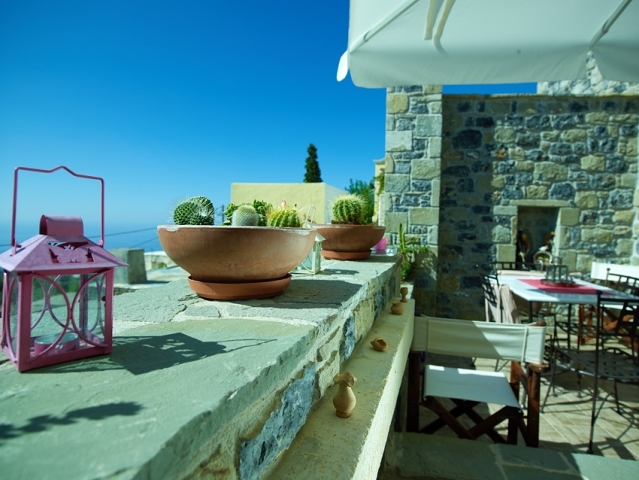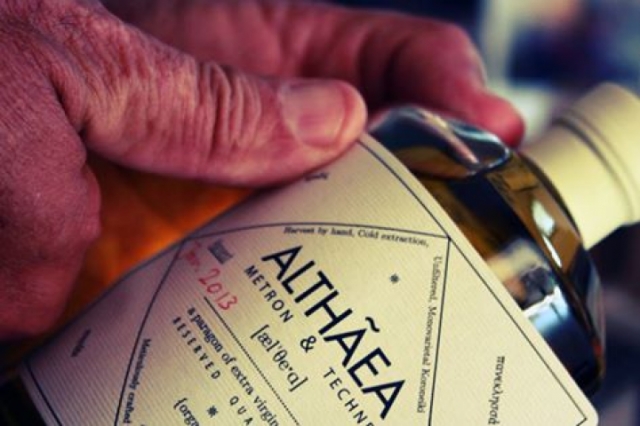Νομός: Λασιθίου

Ιερά Μονή Αγίων Αποστόλων Κάτω Καρκασιών
The Monastery of Holy Apostles is located at Karkasa just 400m southwest from Sotiras Monastery, 4km west of Anatoli village and 16km far from Ierapetra Town, on the southern slopes of Lasithi Mountains.
This was once a small monastic complex which supervised the neighboring monasteries of Jesus Christ the Saviour, and Virgin Mary ‘Panagia Vagionea’. The monastery of Karkasa (or Karkasia) is well-known from archival sources of the 15th century and must have included all these three small monasteries. In the late 14th century, the scholar monk Nilos Damilas lived in the monastery. He was known for his action against the pro-Western theologians of the era and left important writings.
Only ruins survive from the cells of the original monastery. The catholicon is a single-nave barrel-vaulted church of 10.00 x 5.40 m, with two transverse reinforcing arches. The church is adorned on all its internal surfaces with frescoes, which constitute a comprehensive iconographic whole, including a total of 31 scenes.
Apart from the wider Christological cycle on the northern wall (22 out of its 26 scenes survive), above the zone of saints depicted in full body, we can see a cycle of the martyrdom of the Apostles, to whom the church is dedicated. The preservation of the iconographic decoration is unsatisfactory, however, on the basis of a 1429 incision, it has been dated to the 15th century (Maderakis 1988, 59). Two important icons which were in its altar-screen with distinct elements of Constantinople-styled art dated to around 1400 are nowadays kept at the Church of All Saints in the village of Anatoli.
The monastery itself is currently inactive and belongs to the parish of Anatoli.
Μέρη κοντινά με Ιερά Μονή Αγίων Αποστόλων Κάτω Καρκασιών
Χωριό του Ανατέλλοντος ηλίου όπως δηλώνει το όνομα του. Παλιό, ιστορικό, παραδοσιακό χωριό 17 ΚΜ βορειοδυτικά της Ιεράπετρας σε υψόμετρο 600 Μ. Τα σπίτια του ορατά από τον, είναι φωλιασμένα στο οχυρό βουνό της Ανατολής.
Την δεκαετία του 70 οι περισσότεροι κάτοικοι της Ανατολής κατέβηκαν στον κάμπο και ασχολούνται με τις θερμοκηπιακές καλλιέργειες. Ίδρυσαν μαζί με κατοίκους από άλλα χωριά τους συνοικισμούς Στόμιο, Νέα Ανατολή, Αμμουδάρες. Το μικρό γραφικό χωριό Καλόγεροι που σύμφωνα με την παράδοση κτίστηκε από κάποιο Τούρκο Αγά ανήκει στην Ανατολή. Αναφέρεται από την εποχή της Ενετοκρατίας. Το 1583 μαζί με τους Καλογέρους είχε 666 κατοίκους. Το 1951 με 897 και το 2001 μαζί με την Νέα Ανατολή 1235 κατοίκους. Υπάρχει ερειπωμένος ο Πύργος του Ενετού φεουδάρχη βόρεια του χωριού.
Πολλά τα εκκλησιαστικά της μνημεία, οι Μονές, οι μεγάλης τέχνης Βυζαντινές εικόνες. Ο παλιός παραδοσιακός οικισμός της Ανατολής έμεινε αναλλοίωτος στο χρόνο, με τα πετρόχτιστα σπίτια, τα σοκάκια, την παλιά Κάτω Βρύση.
To χωρίο είναι σε πρόγραμμα αναπαλαίωσης, χαρακτηρίστηκε παραδοσιακός οικισμός. Η Ανατολή Ιεράπετρας θα είναι ένα από τα ωραιότερα παραδοσιακά χωριά της Κρήτης, με το θαυμάσιο κλίμα, την καταπληκτική θέα, το απαράμιλλο φυσικό.
Στο βραχώδη λόφο του Σταυρωμένου Ανατολής ιδρύθηκε τη μινωική εποχή ένα σημαντικό Ιερό Κορυφής. Η εκπληκτική του θέση επιτρέπει τον εποπτικό έλεγχο τόσο βόρεια στο Κρητικό πέλαγος όσο και νότια στο Λιβυκό, ενώ στο άμεσο περιβάλλον του βρίσκεται και το μινωικό κτήριο στον Γαϊδουροφά. Όπως φανερώνουν τα διάφορα αναθήματα που βρέθηκαν στο χώρο, η λατρεία στη θέση αυτή συνεχίστηκε ως τους ρωμαϊκούς χρόνους.
Κατά την Μεσομινωική περίοδο (21001700 π.Χ.) έγινε ιδιαίτερα προσφιλής η άσκηση της δημόσιας λατρείας στην ύπαιθρο και συγκεκριμένα στις ψηλές κορυφές των βουνών. Εδώ συνήθιζαν να συγκεντρώνονται οι κάτοικοι των γύρω οικισμών για να αποθέσουν τα αφιερώματα τους στους επίπεδους βράχους ή σε σχισμές, τα οποία στην πλειοψηφία τους ήταν πήλινα ειδώλια ανδρών, γυναικών και ζώων. Σε ελάχιστες περιπτώσεις ιερών είχαν κατασκευαστεί ξερολιθικοί τοίχοι για μια στοιχειώδη οργάνωση του χώρου.
The Monastery of Holy Apostles is located at Karkasa just 400m southwest from Sotiras Monastery, 4km west of Anatoli village and 16km far from Ierapetra Town, on the southern slopes of Lasithi Mountains.
This was once a small monastic complex which supervised the neighboring monasteries of Jesus Christ the Saviour, and Virgin Mary ‘Panagia Vagionea’. The monastery of Karkasa (or Karkasia) is well-known from archival sources of the 15th century and must have included all these three small monasteries. In the late 14th century, the scholar monk Nilos Damilas lived in the monastery. He was known for his action against the pro-Western theologians of the era and left important writings.
Only ruins survive from the cells of the original monastery. The catholicon is a single-nave barrel-vaulted church of 10.00 x 5.40 m, with two transverse reinforcing arches. The church is adorned on all its internal surfaces with frescoes, which constitute a comprehensive iconographic whole, including a total of 31 scenes.
Apart from the wider Christological cycle on the northern wall (22 out of its 26 scenes survive), above the zone of saints depicted in full body, we can see a cycle of the martyrdom of the Apostles, to whom the church is dedicated. The preservation of the iconographic decoration is unsatisfactory, however, on the basis of a 1429 incision, it has been dated to the 15th century (Maderakis 1988, 59). Two important icons which were in its altar-screen with distinct elements of Constantinople-styled art dated to around 1400 are nowadays kept at the Church of All Saints in the village of Anatoli.
The monastery itself is currently inactive and belongs to the parish of Anatoli.










